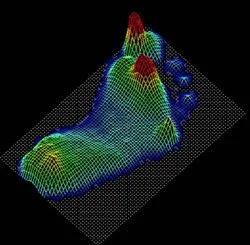Forefoot Pain
There are many reasons for the cause of forefoot pain. Forefoot pain is also known as metatarsalgia. It is important to diagnose this condition accurately and find the root cause to treat it adequately. There are many different methods used to treat forefoot pain such as; injection therapy, mobilisation, orthotic therapy, surgery and rehabilitation. The main way to identify the cause for metatarsalgia is through kinetic analysis where the force and pressure on the forefoot is analysed. Kinetic analysis helps to make sure that the forefoot pressure has normalised with treatment.
There are many causes of metatarsalgia, like Stress Fractures, Morton’s Neuroma, Flexer Tendon Inflammation and Plantar Plate.
When we perfrom a foot scan at our clinic, the computer displays 2D and 3D visual representations of the pressure under your foot. You can see where you have too much or too little pressure.
Stress Fractures
Stress fractures are very common and it is vital that they are diagnosed and treated as quickly as possible. The consequences can be more serious if this stress fracture turns into a full fracture. When the foot does not function properly and due to this there is an overload on the metatarsal, this usually causes the stress fracture. A full biomechanical assessment is important to work out how well the foot is functioning and what kind of treatment will be beneficial.
Morton’s Neuroma
Morton’s Neuroma is a condition where the nerve becomes thick and imposed. A non-surgical treatment can work well if the nerve has not become too inflamed. Where the nerve is swollen and inflamed, then surgery or injection therapy will possibly be needed.
Flexor Tendon Inflammation or Plantar Plate
The most common cause of forefoot pain is Flexor Tendon Inflammation. When the foot is not stable then the metatarsal head becomes overloaded, hence causing forefoot pain. Unless the condition is severe, it can generally be treated in a non-surgical way.
Freiberg’s Infarction is another common injury where the metatarsal head breaks down when the circulation and movement is compromised. This generally happens due to a prior injury such as a stubbed toe. There are a variety of treatments available from using orthotics to surgery.
Force and pressure in the centre of the foot is the main reason for forefoot pain. Treatment consists of changing footwear, rehabilitation and orthotic therapy to stabilize the foot. Bones in the feet may need to be realigned in severe cases; surgery may be needed for this.

